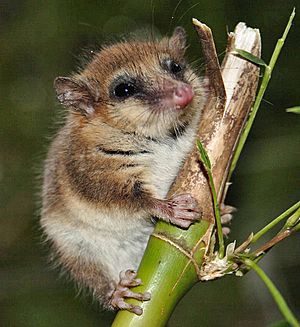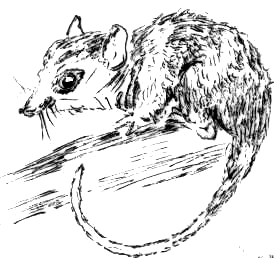Microbiotheres facts for kids
Quick facts for kids MicrobiotheresTemporal range: Early Palaeocene – Recent
|
|
|---|---|
 |
|
| Scientific classification | |
| Kingdom: | |
| Phylum: | |
| Class: | |
| Infraclass: | |
| Superorder: | |
| Order: |
Microbiotheria
Ameghino, 1889
|
| Family: |
Microbiotheriidae
Ameghino, 1887
|
Microbiotheria is a small group of marsupial mammals. Today, there is only one living species: the Monito del Monte. Its name means 'little mountain monkey' in Spanish.
This tiny creature is special because it is the only marsupial from the Americas that belongs to a superorder called Australidelphia. All other marsupials in the Americas are part of a different group called Ameridelphia.
The Monito del Monte is active at night (it is nocturnal) and lives in trees (it is arboreal). You can find it in the thick bamboo forests of the southern Andes mountains, where it is usually rainy and cool. It mostly eats insects and other small creatures. Sometimes, it also enjoys fruit.
Scientists once thought these animals were related to opossums. But they found many differences, especially in their skulls. So, they gave them their own special group.
Ancient Journeys: Marsupials Across Continents
For a long time, scientists wondered if marsupials from South America were the ancestors of those found in Australia. This idea made sense because the two continents were once connected. They were linked through Antarctica many millions of years ago, during the early Cainozoic era.
The oldest known marsupial in Australia is an animal called Djarthia. It was a primitive, mouse-like creature that lived about 55 million years ago. Scientists believed Djarthia was the earliest known Australidelphian. This research suggested that the Monito del Monte was the last living member of a group (or clade) that included Djarthia.
In 2010, scientists studied the DNA of marsupials. They looked at special parts of their DNA called retrotransposons. This study confirmed that the Monito del Monte belongs in the Australidelphia group. It also showed that it is the most basic or earliest branch of that superorder.
The study also confirmed that the earliest marsupial groups are the other two South American lineages: Didelphimorphia and Paucituberculata. This means that the Australidelphia group first appeared in South America. The ancestors of all other living marsupials likely traveled to Australia in one big journey, after the Microbiotheria group had already branched off.
See also
 In Spanish: Microbiotheria para niños
In Spanish: Microbiotheria para niños


